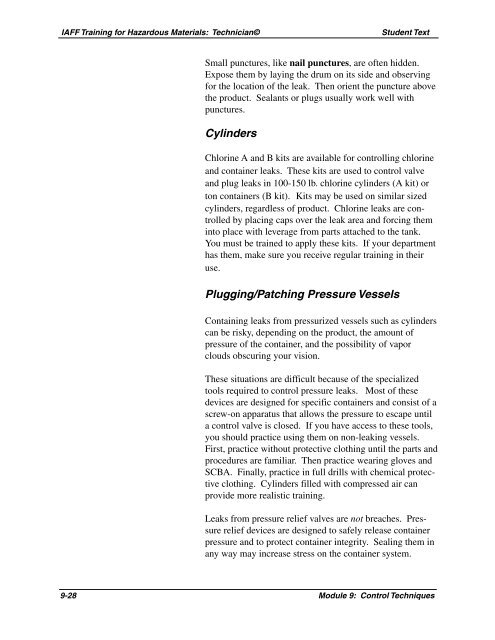Module 9: Control Techniques - International Association of Fire ...
Module 9: Control Techniques - International Association of Fire ...
Module 9: Control Techniques - International Association of Fire ...
Create successful ePaper yourself
Turn your PDF publications into a flip-book with our unique Google optimized e-Paper software.
IAFF Training for Hazardous Materials: Technician©<br />
Student Text<br />
Small punctures, like nail punctures, are <strong>of</strong>ten hidden.<br />
Expose them by laying the drum on its side and observing<br />
for the location <strong>of</strong> the leak. Then orient the puncture above<br />
the product. Sealants or plugs usually work well with<br />
punctures.<br />
Cylinders<br />
Chlorine A and B kits are available for controlling chlorine<br />
and container leaks. These kits are used to control valve<br />
and plug leaks in 100-150 lb. chlorine cylinders (A kit) or<br />
ton containers (B kit). Kits may be used on similar sized<br />
cylinders, regardless <strong>of</strong> product. Chlorine leaks are controlled<br />
by placing caps over the leak area and forcing them<br />
into place with leverage from parts attached to the tank.<br />
You must be trained to apply these kits. If your department<br />
has them, make sure you receive regular training in their<br />
use.<br />
Plugging/Patching Pressure Vessels<br />
Containing leaks from pressurized vessels such as cylinders<br />
can be risky, depending on the product, the amount <strong>of</strong><br />
pressure <strong>of</strong> the container, and the possibility <strong>of</strong> vapor<br />
clouds obscuring your vision.<br />
These situations are difficult because <strong>of</strong> the specialized<br />
tools required to control pressure leaks. Most <strong>of</strong> these<br />
devices are designed for specific containers and consist <strong>of</strong> a<br />
screw-on apparatus that allows the pressure to escape until<br />
a control valve is closed. If you have access to these tools,<br />
you should practice using them on non-leaking vessels.<br />
First, practice without protective clothing until the parts and<br />
procedures are familiar. Then practice wearing gloves and<br />
SCBA. Finally, practice in full drills with chemical protective<br />
clothing. Cylinders filled with compressed air can<br />
provide more realistic training.<br />
Leaks from pressure relief valves are not breaches. Pressure<br />
relief devices are designed to safely release container<br />
pressure and to protect container integrity. Sealing them in<br />
any way may increase stress on the container system.<br />
9-28 <strong>Module</strong> 9: <strong>Control</strong> <strong>Techniques</strong>
















